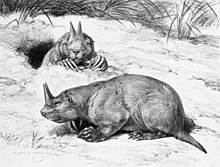| Mylagaulids Temporal range: 28–5 Ma PreꞒ Ꞓ O S D C P T J K Pg N Late Oligocene - Early Pliocene | |
|---|---|

| |
| Reconstruction of Ceratogaulus hatcheri | |
| Scientific classification | |
| Domain: | Eukaryota |
| Kingdom: | Animalia |
| Phylum: | Chordata |
| Class: | Mammalia |
| Order: | Rodentia |
| Suborder: | Sciuromorpha |
| Family: | †Mylagaulidae Cope, 1881 |
| Subfamilies | |
|
See text | |
The Mylagaulidae or mylagaulids are an extinct clade of sciuromorph rodents nested within the family Aplodontiidae. They are known from the Neogene of North America and China. The oldest member is the Late Oligocene Trilaccogaulus montanensis that lived some 29 million years ago (Mya), and the youngest was Ceratogaulus hatcheri—formerly in the invalid genus "Epigaulus" —which was found barely into the Pliocene, some 5 Mya.
Systematics
Three subfamilies are recognized. The taxonomy of Galbreathia is not resolved; it might belong in Mylagaulinae, but lacks the characteristic apomorphies.
Promylagaulinae
- Genus Crucimys
- Genus Promylagaulus
- Genus Trilaccogaulus
- Genus Simpligaulus
- Genus Mesogaulus - includes Mylagaulodon
Mylagaulinae
- Genus Alphagaulus (paraphyletic)
- Genus Ceratogaulus - includes "Epigaulus"
- Genus Hesperogaulus
- Genus Mylagaulus
- Genus Notogaulus
- Genus Pterogaulus
- Genus Umbogaulus
- Genus Galbreathia - basal in Mylagaulinae?
Footnotes
- Calede, Jonathan J. M.; Samuels, Joshua X. (2020-09-01). "A new species of Ceratogaulus from Nebraska and the evolution of nasal horns in Mylagaulidae (Mammalia, Rodentia, Aplodontioidea)". Journal of Systematic Palaeontology. 18 (17): 1395–1414. doi:10.1080/14772019.2020.1765889. ISSN 1477-2019. S2CID 219902187.
- ^ Hopkins, Samantha S. B. (August 2008). "Phylogeny and evolutionary history of the Aplodontoidea (Mammalia: Rodentia)". Zoological Journal of the Linnean Society. 153 (4): 769–838. doi:10.1111/j.1096-3642.2008.00399.x. hdl:1794/10750.
- Tesakov, A. S.; Lopatin, A. V. (January 2015). "First record of Mylagaulid rodents (Rodentia, mammalia) from the Miocene of Eastern Siberia (Olkhon island, Baikal Lake, Irkutsk Region, Russia)". Doklady Biological Sciences. 460 (1): 23–26. doi:10.1134/S0012496615010032. ISSN 0012-4966. PMID 25773245. S2CID 254412481.
- Wu; et al. "Mylagaulids (Mammalia: Rodentia) from the early Middle Miocene of northern Junggar Basin" (PDF). Retrieved 2023-01-05.
- Korth, William W. (September 2013). "Mylagaulid Rodents (Mammalia: Rodentia: Mylagaulidae) from the Middle Miocene (Barstovian) of New Mexico". Annals of Carnegie Museum. 81 (4): 233–245. doi:10.2992/007.081.0403. ISSN 0097-4463. S2CID 86013119.
- ^ Hopkins (2005)
References
- Hopkins, Samantha S.B. (2005): The evolution of fossoriality and the adaptive role of horns in the Mylagaulidae (Mammalia: Rodentia). Proc. R. Soc. B 272(1573): 1705–1713. doi:10.1098/rspb.2005.3171 PDF fulltext
- McKenna, M. C, and S. K. Bell (1997): Classification of Mammals Above the Species Level. Columbia University Press. ISBN 0-231-11012-X
| Prehistoric families in order Rodentia | |
|---|---|
| |
| Sciuromorpha | |
| Castorimorpha | |
| Myomorpha | |
| Anomaluromorpha | |
| Hystricomorpha | |
| Theridomorpha |
|
| incertae sedis | |
| See also: Category | |
| Taxon identifiers | |
|---|---|
| Mylagaulidae | |
This article about a prehistoric rodent is a stub. You can help Misplaced Pages by expanding it. |